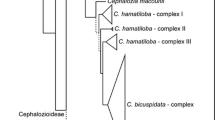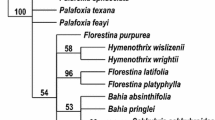Abstract
The trnT-F region in chloroplasts was sequenced to elucidate interspecific phylogenetic relationships in the genus Cicer. Twenty-five species representing four sections and two outgroups were analyzed. A phylogenetic analysis revealed three major clades in the genus Cicer. Inferred phylogenetic relationships support multiple origins of annual species in the genus Cicer. Low variation within the most perennial species in the sequence regions suggests they may have originated during a period of rapid diversification after the genus arose. High levels of sequence divergence, biogeographical patterns and morphological traits between African and Eurasian groups of species suggest that Cicer may have independently diverged on each continent. Phylogenetic analysis of sequence data did not support the monophyly of the currently recognized sections and indicated the need for a revision of the infrageneric classification.

Similar content being viewed by others
References
Ahmad F (1999) Random amplified polymorphic DNA (RAPD) analysis reveals genetic relationships among the annual Cicer species. Theor Appl Genet 98:657–663
Ahmad F, Slinkard AE (1992) Genetic relationships in the genus Cicer L. as revealed by polyacrylamide gel electrophoresis of seed storage proteins. Theor Appl Genet 84:688–692
Ahmad F, Gaur PM, Slinkard AE (1992) Isozyme polymorphism and phylogenetic interpretations in the genus Cicer L. Theor Appl Genet 83:620–627
Catalàn P, Kellogg EA, Olmstead RG (1997) Phylogeny of Poaceae subfamily Pooideae based on chloroplast ndhF gene sequences. Mol Phylogenet Evol 8:150–166
Choumane W, Winter P, Weigand F, Kahl G (2000) Conservation and variability of sequence-tagged microsatellite sites (STMs) from chickpea (Cicer arietinum L.) within the genus Cicer. Theor Appl Genet 101:269–278
Clegg MT, Zurawski G (1992) Chloroplast DNA and the study of plant phylogeny. In: Soltis PS, Soltis DE, Doyle JJ (eds) Molecular systematics of plants. Chapman and Hall, London, pp 1–13
Downie SR, Katz-Downie DS, Watson MF (2000) A phylogeny of the flowering plant family Apiaceae based on chloroplast DNA rpl16 and rpoC1 intron sequences: towards a suprageneric classification of subfamily Apioideae. Am J Bot 87:273–292
Doyle JJ, Doyle JL (1987) A rapid DNA isolation procedure for small quantities of fresh leaf tissue. Phytochem Bull 19:11–15
Felsenstein J (1985) Confidence limits on phylogenies: an approach using the bootstrap. Evolution 39:783–791
Gielly L, Taberlet P (1996) A phylogeny of the European gentians inferred from chloroplast trnL (UAA) intron sequences. Bot J Linn Soc 120:57–75
Iruela M, Rubio J, Cubero JI, Gil J, Millan T (2002) Phylogenetic analysis in the genus Cicer and cultivated chickpea using RAPD and ISSR markers. Theor Appl Genet 104:643–651
Javadi F, Yamaguchi H (2004) RAPD and seed coat morphology variation in annual and perennial species of the genus Cicer L. Genet Res Crop Evol (in press)
Kazan K, Muehlbauer FJ (1991) Allozyme variation and phylogeny in annual species of Cicer (Leguminosae). Plant Syst Evol 175:11–21
Ladbi M, Robertson LD, Singh KB, Charrier A (1996) Genetic diversity and phylogenetic relationships among the annual Cicer species as revealed by isozyme polymorphism. Euphytica 88:181–188
Ladizinsky G, Adler A (1975) The origin of chickpea as indicated by seed protein electrophoresis. Isr J Bot 24:183–189
Ladizinsky G, Adler A (1976) Genetic relationships among the annual species of Cicer L. Theor Appl Genet 48:197–203
Mummenhoff K, Brüggemann H, Bowman JL (2001) Chloroplast DNA phylogeny and biogeography of Lepidium (Brassicaceae). Am J Bot 88 :2051–2063
Ohsako T, Ohnishi O (2000) Intra- and interspecific phylogeny of wild Fagopyrum (Polygonaceae) species based on nucleotide sequences of noncoding regions in chloroplast DNA. Am J Bot 87:573–582
Popov MG (1976) Genus Cicer and its species: on the problem of origin of mediterranean flora, and experiment in morphological and geographical monographing. Indian National Scientific Documentation Centre, New Delhi
Serret DM, Udupa SM, Weigand F (1997) Assessment of genetic diversity of cultivated chickpea using microsatelite-derived RFLP markers: implications for origin. Plant Breed 116:573–578
Singh KB, Ocampo B (1993) Interspecific hybridization in annual Cicer species. J Genet Breed 47:199–204
Sudupak MA, Akkaya MS, Kence A (2002) Analysis of genetic relationships among perennial and annual Cicer species growing in Turkey using RAPD markers. Theor Appl Genet 105:1220–1228
Sudupak MA, Akkaya MS, Kence A (2003) Genetic relationships among perennial and annual Cicer species growing in Turkey assessed by AFLP. Theor Appl Genet 10.1007/s00122-003-1505-8
Swofford DL (2000) PAUP*: phylogenetic analysis using parsimony (*and other methods). Version 4.0b4a. Sinauer Associates, Sunderland, Mass.
Taberlet P, Gielly L, Pautou G, Bouvet J (1991) Universal primers for amplification of three non-coding regions of chloroplast DNA. Plant Mol Biol 17:1105–1109
Tayyar RI, Waines JG (1996) Genetic relationships among annual species of Cicer (Fabaceae) using isozyme variation. Theor Appl Genet 92:245–254
Udupa SM, Robertson LD, Weigand F, Baum M, Kahl G (1999) Allelic variation at (TAA)n microsatellite loci in a world collection of chickpea (Cicer arietinum L.) germplasm. Mol Gen Genet 261:354–363
Van der Maesen LJG (1972) Cicer L.: a monograph of the genus, with especial reference to the chickpea (Cicer arietinum L.), its ecology and cultivation. Mededelingen Landbouwhogeschool Wageningen, Wageningen
Van der Maesen LJG (1987) Origin, history and taxonomy of chickpea. In: Saxena MC, Singh KB (eds) The chickpea. International Publishing, London, pp 11–34
Zohary D, Hopf M (1993) Domestication of plants in the old world. Oxford University Press, Oxford
Acknowledgements
We are grateful to Fred Muehlbauer and Claric Coyne of the United States Department of Agriculture and Ali Asghar Maassoumi of the Central Herbarium of Iran for kindly providing seeds and samples from herbarium specimens. We also thank the National Plant Gene Bank of Iran, the Center for Agricultural Research in Dry Areas and the International Crops Research Institute for the Semi-Arid Tropics for seeds of some Cicer species. We wish to extend our gratitude to Yuichiro Nakayama, Shahrokh Kazempour Osaloo, Martin F. Wojciechowski, Aaron Liston and Akiko Soejima for their technical advice and suggestions during this research. We thank Christian Möllers and two anonymous reviewers for detailed comments and advice that greatly improved the manuscript.
Author information
Authors and Affiliations
Corresponding author
Additional information
Communicated by C. Möllers
Rights and permissions
About this article
Cite this article
Javadi, F., Yamaguchi, H. Interspecific relationships of the genus Cicer L. (Fabaceae) based on trnT-F sequences. Theor Appl Genet 109, 317–322 (2004). https://doi.org/10.1007/s00122-004-1622-z
Received:
Accepted:
Published:
Issue Date:
DOI: https://doi.org/10.1007/s00122-004-1622-z




